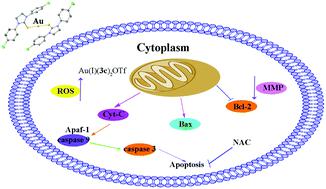当前位置:
X-MOL 学术
›
Metallomics
›
论文详情
Our official English website, www.x-mol.net, welcomes your feedback! (Note: you will need to create a separate account there.)
Synthesis, characterization, and antitumor properties of Au(i)-thiourea complexes.
Metallomics ( IF 3.4 ) Pub Date : 2019-11-15 , DOI: 10.1039/c9mt00232d Bingqiong Yu 1 , Yanhong Liu , Xian Peng , Siyu Hua , Gangcheng Zhou , Kun Yan , Yi Liu
Metallomics ( IF 3.4 ) Pub Date : 2019-11-15 , DOI: 10.1039/c9mt00232d Bingqiong Yu 1 , Yanhong Liu , Xian Peng , Siyu Hua , Gangcheng Zhou , Kun Yan , Yi Liu
Affiliation

|
The anticancer property of cisplatin has stimulated the development of metal complexes as antitumor agents. Among these complexes, metal thiourea complexes have attracted sufficient attention, and they possess the potential possibility to become new antitumor metallodrugs. Herein, four Au(I) complexes derived from N,N-disubstituted cyclic thiourea ligands were synthesized and characterized. The crystal structure analysis indicated that the complex Au(I)(3c)2OTf was a mononuclear crystal structure with Au(I) coordinated by two sulfur atoms. These Au(I) complexes exhibited excellent toxicities against several tumor cell lines, especially complex Au(I)(3c)2OTf (IC50 = 8.06 μM against HeLa). It was found that Au(I)(3c)2OTf triggered a burst of ROS, disrupted the mitochondrial membrane potential (MMP), subsequently released Cyt-c, and then triggered the activation of caspase 9, caspase 7 and caspase 3. Mechanism experiments manifested that Au(I)(3c)2OTf induced the down-regulation of Bcl-2 and up-regulation of Bax, which further indicated that Au(I)(3c)2OTf triggered mitochondria-mediated apoptosis. In addition, the ROS scavenger-NAC completely blocked the apoptosis and inhibited the reduction of MMP, showing that Au(I)(3c)2OTf induced a ROS-dependent apoptosis pathway. These results indicate that Au(I)(3c)2OTf is worthy of in-depth research as an antitumor agent and may throw light on a better understanding of the effect of thiourea derivatives on antitumor mechanisms.
中文翻译:

Au(i)-硫脲复合物的合成,表征和抗肿瘤性能。
顺铂的抗癌特性刺激了金属复合物作为抗肿瘤剂的发展。在这些配合物中,金属硫脲配合物已引起足够的重视,并且它们具有成为新的抗肿瘤金属药物的潜在可能性。在此,合成并表征了衍生自N,N-二取代的环状硫脲配体的四种Au(I)配合物。晶体结构分析表明,络合物Au(I)(3c)2 OTf是具有两个硫原子配位的Au(I)的单核晶体结构。这些金(我)复合物对几种肿瘤细胞系表现出优异的毒性,尤其是复合物Au(I)(3c)2 OTf(对HeLa的IC 50 = 8.06μM)。发现Au(I)(3c)2 OTf触发了ROS爆发,破坏了线粒体膜电位(MMP),随后释放了Cyt- c,然后触发了caspase 9,caspase 7和caspase 3的激活。实验表明,Au(I)(3c)2 OTf诱导了Bcl-2的下调和Bax的上调,进一步表明Au(I)(3c)2OTf触发线粒体介导的细胞凋亡。此外,ROS清除剂NAC完全阻断凋亡并抑制MMP的减少,表明Au(I)(3c)2 OTf诱导了ROS依赖的凋亡途径。这些结果表明Au(I)(3c)2 OTf作为抗肿瘤剂值得深入研究,可能有助于更好地了解硫脲衍生物对抗肿瘤作用的作用。
更新日期:2019-11-15
中文翻译:

Au(i)-硫脲复合物的合成,表征和抗肿瘤性能。
顺铂的抗癌特性刺激了金属复合物作为抗肿瘤剂的发展。在这些配合物中,金属硫脲配合物已引起足够的重视,并且它们具有成为新的抗肿瘤金属药物的潜在可能性。在此,合成并表征了衍生自N,N-二取代的环状硫脲配体的四种Au(I)配合物。晶体结构分析表明,络合物Au(I)(3c)2 OTf是具有两个硫原子配位的Au(I)的单核晶体结构。这些金(我)复合物对几种肿瘤细胞系表现出优异的毒性,尤其是复合物Au(I)(3c)2 OTf(对HeLa的IC 50 = 8.06μM)。发现Au(I)(3c)2 OTf触发了ROS爆发,破坏了线粒体膜电位(MMP),随后释放了Cyt- c,然后触发了caspase 9,caspase 7和caspase 3的激活。实验表明,Au(I)(3c)2 OTf诱导了Bcl-2的下调和Bax的上调,进一步表明Au(I)(3c)2OTf触发线粒体介导的细胞凋亡。此外,ROS清除剂NAC完全阻断凋亡并抑制MMP的减少,表明Au(I)(3c)2 OTf诱导了ROS依赖的凋亡途径。这些结果表明Au(I)(3c)2 OTf作为抗肿瘤剂值得深入研究,可能有助于更好地了解硫脲衍生物对抗肿瘤作用的作用。


























 京公网安备 11010802027423号
京公网安备 11010802027423号